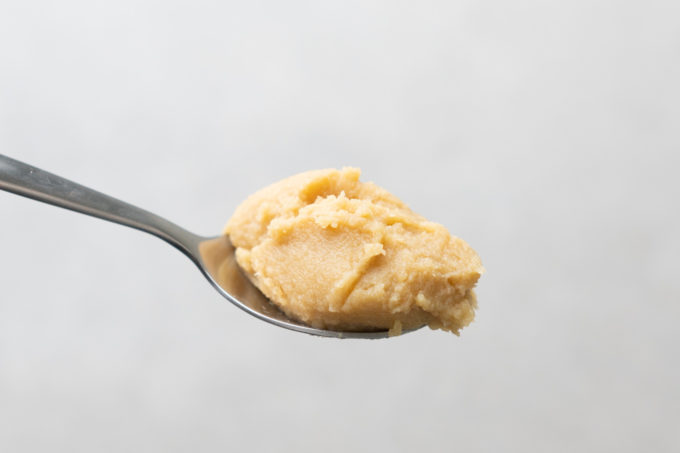
With its distinct flavor, miso paste is an excellent addition to any recipe. Japanese cuisine relies heavily on this ingredient, but it’s not something you’ll find in most Western kitchens. So if you don’t have miso paste on hand to use in your recipe, you’ll have to come up with an alternative.
Keep in mind that the flavor of miso paste is extremely distinct and difficult to replicate. However, there are a few items that can be used in a pinch to get as close to the flavor as possible.
What is miso & what does it taste like?

Miso is a nutrient-dense, umami-flavored paste made from fermented soybeans. A rice spore known as koji is used to ferment a mixture of soybeans, salt, and water. The more time the paste is allowed to ferment, the more flavorful and bold it becomes. As the fermentation process progresses, the final product’s texture becomes chunkier.
The four main types of miso paste are soybean miso, rice miso, barley miso, and blended miso, which are all based on the primary ingredient. Miso can also be categorized based on its flavor, region, and color.
This fermented soybean paste can be described as sour, salty, and savory on its own. Depending on the ingredients used and the length of fermentation, the flavor can vary greatly. Some miso can be lighter in taste and color, while others can be bolder. It can be used in various dishes, including soups, stir-fries, marinades, desserts, and more.
Where to buy miso before resorting to alternatives

The refrigerated and Asian sections of your local grocery store are likely to have miso on hand, making it easy to find. In addition, specialty food stores, such as those that focus on organic and healthy products, often carry miso as well.
In the event that you can’t find miso in your local supermarket, most Asian grocery stores, particularly Japanese supermarkets, carry miso paste and generally with several different types of miso you can select from. If you’re unable to find it in your area, you can always order it online. Most varieties of miso paste are available for purchase online.
The best substitutes for miso paste:
Trying to find a substitute for miso paste is tricky because of the difficulty of finding an ingredient with the same taste and texture. A few substitutes can replicate either the taste or the texture, while others fall somewhere in between.
1. Soy sauce

Soy sauce is a popular miso paste alternative because it has a flavor profile that is similar to miso. It may be a closer and better match for some miso paste varieties than others. For example, it has a flavor that is more reminiscent of red miso than of white miso.
Given that soy sauce is made from the same ingredients as miso, it is the most similar in flavor to the Japanese condiment. Miso paste and soy sauce have very similar flavors, but they do not have the same consistency. Nonetheless, soy sauce, as a red miso paste substitute, can enhance a dish’s umami flavor.
2. Tahini

Because tahini has a similar texture to miso paste, it is another common substitute for the paste. If you’re looking for a white miso paste substitute, tahini is a better option than red miso because it’s less fermented and milder tasting. However, unlike soy sauce and fish sauce, tahini lacks miso’s distinct flavor.
Using it in a dish that calls for miso paste as a base will necessitate the addition of other ingredients. Fortunately, the umami flavor of miso paste can be replicated using a mixture of tahini, soy sauce, or even fish sauce. Regardless, consider using tahini as a miso paste alternative if you’re looking to bulk up and add a thicker consistency to a dish. Like miso, it is a paste that can be used to thicken dishes.
3. Fish sauce

Fish sauce, like soy sauce, can enhance umami flavor and be used as a red miso paste substitute. It has a salty and fermented taste because it is made from fermented fish. Fish sauce, unlike miso, is in liquid form and has a much stronger flavor than miso, so a small amount goes a long way with this sauce. It’s best to start small and work your way up to the level of flavor you desire. Additionally, it has a strong fishy aroma.
While fish sauce lacks the same texture as miso paste, it can provide a similar flavor, especially in a pinch. Of course, if you wish to thicken the texture, you can always add tahini into the dish.
4. Soybean paste

Soybean paste, a fermented bean paste, can be used as a substitute for miso paste in many dishes. It is commonly used as a seasoning in stews, soups, and even dipping sauces. This paste can be used as a red miso paste substitute, but keep in mind that it is quite salty. Start with a small amount if you decide to use it. If you want to, you can add more as you go.
5. Tamari

Tamari is a good red miso paste substitute because it has a similar flavor. Umami and salt dominate the flavor profile of this sauce. Because of its thick consistency, it is a good substitute for some of the consistency provided by miso. Yet, keep in mind that it will not have the same effect because it is only a liquid. Tamari is also quite rich, so be careful when adding it to the dish. Also learn how tamari differs from soy sauce.
6. Vegetable Stock

Another good white miso paste substitute is vegetable stock. Despite being made from vegetables rather than proteins, it has a strong umami flavor similar to soy sauce and fish sauce. However, it will not thicken the dish in the same way that miso would. Vegetable stock also lacks the fermented flavor provided by miso. Still, if miso isn’t available, it’s a great alternative for adding saltiness and umami to a dish.
7. Salt

With the right amount of salt, you can sometimes get the flavor of miso paste in a dish. However, salt does not have the same texture as miso. Furthermore, the umami flavor of miso paste cannot be replicated with salt. Finally, salt lacks the tangy flavor of miso. Therefore, while it can be used as a miso paste substitute, it should not be your first choice.









